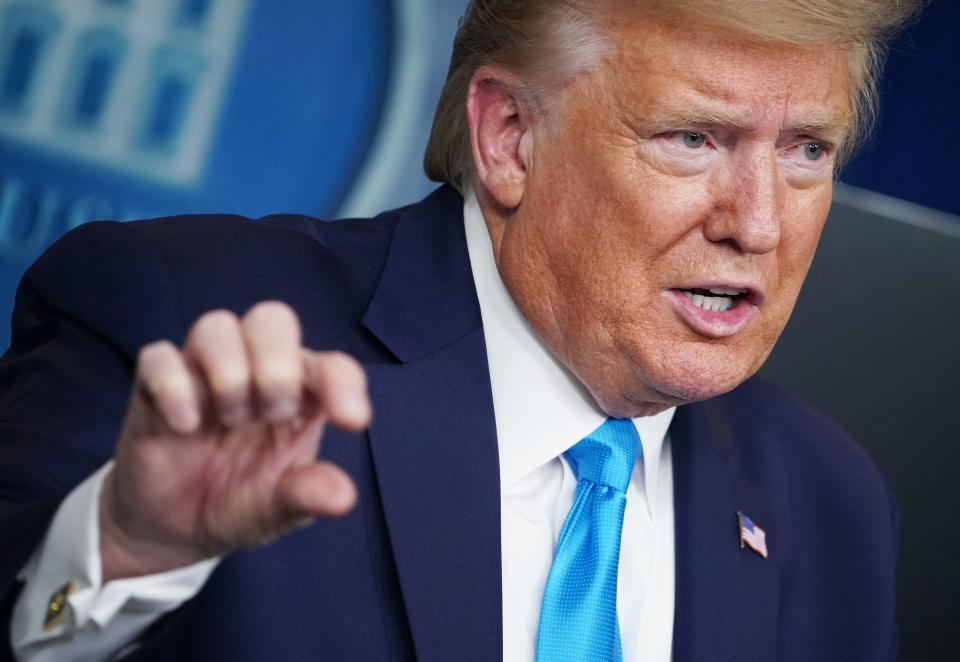Trump is peddling false hope on the economy
First it was reopening by Easter. Then by the end of April. Now, there’s “light at the end of the tunnel.”
Every tunnel ends, but President Trump’s repeat insistences about reopening businesses and sending people back to work are missing one crucial thing: a plan. Trump calls himself a “cheerleader” for America, but it’s more like he’s peddling false hope about magical solutions instead of leveling with Americans about the severity of the coronavirus crisis and explaining how we get out of this mess.
There are coherent plans out there—just not from Trump. Former FDA Commissioner Scott Gottlieb has a four-phase plan that involves the gradual reopening of schools and businesses, under strict precautions, once the virus is contained. Andy Slavitt, who oversaw Medicare and Medicaid from 2015 to 2017, proposes a 20-point plan to move from defense to offense and slowly start returning to normal.
The Trump administration, by contrast, seems to regard reopening the economy as somebody else’s problem, even as Trump prods and complains. Trump has taken modest steps to ramp up production of ventilators and other scarce medical equipment, but those steps have fallen far short of the warlike mobilization some critics are calling for. Washington, for example, could use emergency powers to take control of the supply chain for medical equipment and prevent price-gouging. Trump hasn’t done that, instead relying on private distributors that are hiking prices and provoking complaints of profiteering.

Financial markets have recovered a portion of steep losses during the last two weeks, fueled by optimism about a possible peak in the number of U.S. coronavirus infections and deaths. But there’s still no clear path forward once the virus ebbs, since relaxing distancing measures and sending people back to work could allow the virus to retrench. Some analysts think the rise in stocks since last March is a bear-market trap, with even deeper losses ahead.
Economists also see a more distant, and slower, recovery than Trump does. “Employment losses will be traumatic, and the rebound post-virus will be U-shaped with a full recovery taking 12 to 18 months,” Oxford Economics predicts. A U-shaped recovery is one with a prolonged bottom, whereas a more preferred V-shaped recovery bottoms out more quickly. “The new normal of fear will feature only a gradual relaxation of social distancing measures and a slow recovery until a medical solution to coronavirus ends the crisis.”
The ultimate medical solution will be a vaccine that provides everybody in the world with immunity, not likely to be widely available until mid or late 2021. There are interim steps that could allow parts of the economy to thaw, but Trump isn’t saying much about them.
The crucial need now is for widespread testing—enough “to accommodate the ability to test everyone with symptoms and their close contacts,” according to Gottlieb’s plan. That means tests as easy to get as a swab for strep throat. Testing has ramped up, but we’re not nearly at the level of being able to test everyone with symptoms. Doctors simply tell such patients to stay home for 14 days and assume they have COVID-19, the illness caused by coronavirus. Testing on a massive scale is vital to be able to identify everyone with the virus, in order to know who can safely move around and who needs to stay home. We also desperately need data on infection rates place by place. Without that kind of data, governors and mayors simply have to assume everybody is infected and everybody, therefore, needs to stay home.
Testing is a touchy topic for Trump, who has said he’s not aware there’s a problem—despite loud complaints from governors—and slammed a government watchdog who published an official report examining testing and equipment shortages during the first two months of the outbreak in the United States.
Trump also says it’s not his administration’s job to straighten out testing problems. “States are supposed to be doing their own testing,” Trump said on April 6. “We’re the federal government. We’re not supposed to stand on street corners doing testing.” With no government leadership on the problem, states are ramping up testing on their own. But it’s taking longer than it would with a muscular federal effort to help, and every day’s delay compounds the economic damage.
Trump has set a trap for himself. He’s creating expectations of a quick return to normal, but he’s not taking the fast action to make that happen. There’s reportedly discussion at the White House of establishing a federal testing plan to help reopen the economy. One has to wonder, what’s taking so long?
Widespread testing is only the start. It will take time to build a profile of the virus’s prevalence and determine where the risk is low enough to start reopening businesses. States will have to be able to actively monitor everyone who tests positive and trace everybody they’ve come in contact with, something that’s now out of reach in overwhelmed hotspots like New York City, New Orleans and Detroit. That will be followed by the widespread rollout of antibody tests to figure out who might have immunity to the virus and can safely move around. And better treatments for those with COVID-19 will come online before there’s a vaccine. There is a coronavirus tunnel, but we’ve barely entered it, and any light might be a mirage.
Rick Newman is the author of four books, including “Rebounders: How Winners Pivot from Setback to Success.” Follow him on Twitter: @rickjnewman. Confidential tip line: rickjnewman@yahoo.com. Encrypted communication available. Click here to get Rick’s stories by email.
Read more:
Follow Yahoo Finance on Twitter, Facebook, Instagram, Flipboard, SmartNews, LinkedIn, YouTube, and reddit.

 Yahoo News
Yahoo News 

